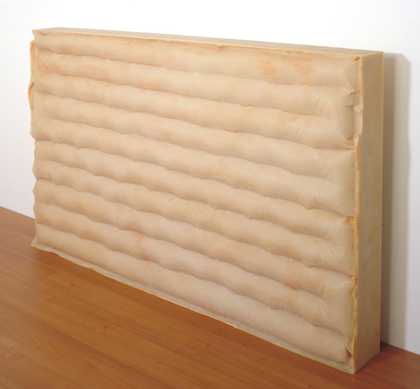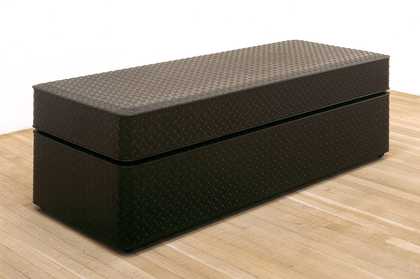Leaking through the skin, passing through the shield, all impacts soaked up and internalised; the air slowly densified and turned into a solid flesh-like form. Framed in its own boundaries, the cast contains a collection of sighs, exhalations, whispers, whimpers, shivers and touch, thoughts, fantasies, hallucinations, dreams, fears and nightmares. Thoughts, conscious or unconscious, infiltrated the encapsulated air; the bodies, coiled up or stretched out, caressing or wrestling one another, pressed the mixture until the gas turned into solid. Encountering the works of Rachel Whiteread is always a mesmerising experience. She literally captures the spaces that we live in or pass through in our everyday life. The usually air-filled negative spaces around objects or architectural settings, distilled and filled with solid material, makes us wonder at all that has gone on inside and around them over time. Untitled (Air Bed II) 1992 is similar to other works of Whiteread but perhaps what makes it slightly different is that it reveals to us something usually hidden or, rather, concealed: the shape of a mattress is not usually visible and with an air mattress, the vulnerable rubber or plastic material must normally be kept protected and concealed. Whiteread’s polyurethane rubber cast reveals the fragile and susceptible volume, which has preserved and embodied memories of its use.

Rachel Whiteread
Untitled (Air Bed II) (1992)
Tate
But if susceptibility or fragility, softness or comfort, are attributes associated with a bed and a mattress, Mona Hatoum’s Divan Bed 1996 sheds all of these qualities, keeping only the façade of a bed to convey diametrically opposed qualities. Like Whiteread, Hatoum also works with the everyday surroundings, reflecting human emotions and experiences through domestic objects. Her transformations of familiar objects are striking and bold even though achieved through subtle alterations. In Divan Bed the replacement of the expected materials by metal weighing three hundred and twenty kilos throws into question the very notion of a bed and its usual associations. The mattress and its base show many of the details of a normal bed, and visually replicate the qualities of a soft mattress. Its familiarity notwithstanding, it speaks, however, about experiences of insecurity, discomfort and suffering.

Mona Hatoum
Divan Bed (1996)
Tate
Poking, prodding and teasing through its cold raised surface, Divan Bed is not affected by use but rather affects whoever uses it. It does not take the shape of the bodies that lie upon it but, instead, its industrial relief pattern would imprint itself onto the skin of whoever attempted to sleep on it, and the metal surface would steal the person’s energy, warmth and tranquility. The bed’s hard surface does not permit access into its hollow insides, but its cold, dark and heavy volume infiltrates the mind, causing nightmares or insomnia. Tossing and twisting bodies, trying to find a comfortable resting position on the bed, receive nothing but an imprinted pattern on their skin and recurrent discomfort. I first came across the works of Whiteread and Hatoum in Sensation, an exhibition held at the Royal Academy of Art in London in 1997 that included works by many so-called Young British Artists (YBAs). At the time I had just finished my high school education in Tehran, with a major in mathematics, and was about to start my art education in London. I remember well the impression their work left on me then. Today, as I am developing my own artistic practice, dealing with subjects relating to everyday life and their potential in discussions of a socio-political context, the works of these two artists continue to be a source of great learning and inspiration. Growing up in a culture of metaphors, with the consequent necessity of learning to decode everyday surroundings, left me with a desire to reflect on the complexities of the seemingly obvious through my work; looking at the works of Whiteread and Hatoum helped open new perspectives onto the concept of the familiar.
Nazgol Ansarinia, January 2011
Artists’ Perspectives provides a platform for international artists to reflect on individual works within Tate’s collection or a related theme. Their texts are published in English and in another language of their choice, offering creative insights into Tate’s collection and art practice today for people in different parts of the world. Artist’s Perspectives is supported by The World Collections Programme
استفاده از این تخت که با سطح سرد و برآمدهاش سیخ میزند و آزار میدهد، تاثیری بر شکلش نمیگذارد، بلکه بر کسی که از آن استفاده میکند تاثیر میگذارد. شکل بدنی را که رویش دراز میکشد به خود نمیگیرد، بلکه در عوض بافت برجسته صنعتی خود را روی پوست میاندازد و فلز سردش انرژی، گرما و آسودگی را از بدنها میرباید. پوشش سختش اجازه ورود به درون تهی خود را نمیدهد، اما حجم سرد، تیره و سنگیناش در ذهن نفوذ میکند و کابوس یا بیخوابی میآورد. تنهای متلاطم و پیچانی که میکوشند وضعیت راحتی روی تخت پیدا کنند، جز نقشی مکرر بر پوست و ناآسودگی مدام چیزی دستگیرشان نمیشود.
من اولین بار در نمایشگاه حس در سال 1997 که آثار تعداد زیادی از هنرمندان جوان انگلیسی YBA را به نمایش گذاشته بود، با آثار وایترید و حاتوم مواجه شدم. در آن زمان، تازه دبیرستان را در رشته ریاضی در تهران تمام کرده بودم و میخواستم تحصیلاتم را در رشته هنر در لندن شروع کنم. تاثیر آثار این دو هنرمند را در آن زمان به خوبی به یاد میآورم. امروز که در حال پیش بردن فعالیت هنری خود، با کار روی روزمرگی و پتانسیل آن برای بحث پیرامون زمینه اجتماعی، سیاسی هستم، آثار این دو هنرمند برایم پیوسته منبع یادگیری و الهام است. بزرگ شدن در فرهنگ استعارهها که ضرورت ناشی از آن رمزگشایی از محیط روزمره است، باعث شد من نیز به بازتاب پیچیدگیهای چیزهای به ظاهر آشکار بپردازم. مشاهده آثار وایترید و حاتوم کمک کردند تا دورنمایی تازه در مفهوم امر آشنا گشوده شود.2011 ژانویه
